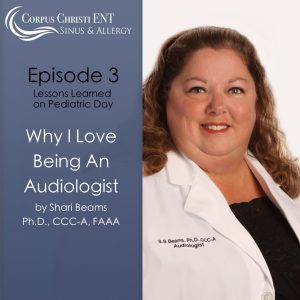
Once a month, the Audiology clinic scheduled pediatric patients to come into the clinic on a certain day. The students assigned to clinic that day were the students currently enrolled in the Pediatric Audiology Course.
I learned some important things during that class.
Ask parents ahead of time about any fears their child may have. One time I was testing a child using a technique called Visual Reinforcement Audiometry. It involves using a pair of speakers that play sounds and boxes underneath that light up with toys inside that move. I had a dog that flipped and barked under one speaker and a monkey that played the cymbals under the other speaker. There is usually a centering toy as well that keeps the child from staring at the toys under the speakers. It is a conditioned response test. Anyway, I was testing a small child one morning. It started off fairly well. Soon however, the child would start to whimper or cry every time, I played a sound from the left speaker. Eventually it got to the point where the child was crying too much to continue the test, so we stopped and I spoke to the parents. I tried to explain that what we could determine about the child’s hearing from what little testing we were able to complete before he became too upset. That’s when the mother told me her child was afraid of dogs! So every time I played the sound where the box was the dog was located the child would cry because he knew the dog was going to light up and bark. I basically tortured the child for 20 minutes trying to test his hearing. I felt really bad about that one.
You are in charge. I learned pretty early on not to give children an option. We don’t say “do you want to play a listening game?” because that gives them the option to say no. You tell them we are going to play a listening game. You have to be in control. I also learned to start talking to the child before you get them into the sound booth. If you have never been in a sound booth, they can be scary places. Typically they are metal, dimly lit boxes. They absorb sound vibrations so they sound funny when you step inside. So I try to interact with the child and try to get them to talk to me and build up a rapport before we get into the scary test place so that maybe I can still get them to talk to me. If they don’t talk to you before you get them into the booth, chances are you are not going to have a very good test.
Take what you can get. I tried to test one child and he wouldn’t raise his hand. Wouldn’t say beep, wouldn’t say yes. Finally got him to say dinosaur. Every time he heard the beep, he would say dinosaur. That’s when I learned that sometimes you have to be willing to accept as a response what the child is willing to give you.
Wooden blocks hurt. We were testing a small child once. I was in the booth as the assistant and my fellow student clinician was running the equipment in the other room. The child was supposed to throw the block into a plastic bucket every time he heard the beep. I handed him the block, cued him to listen and we waited. When he heard the beep, he threw the block, but missed the bucket and hit me. After that I switched to bean bags or cotton balls. I got fewer bruises that way.
I found the pediatric clinic a very challenging time. There were so many lessons learned along the way. Some lessons that carried over and work with older patients as well.